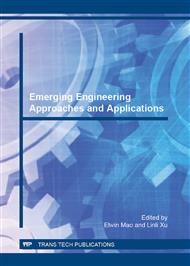p.66
p.71
p.76
p.81
p.86
p.92
p.97
p.105
p.110
Monitoring Dissolved Oxygen Concentration (DOC) in Prawn Aquiculture Water Environment Based on Biological Behavior Characteristics
Abstract:
Biological early warning system using physiological and behavioral responses of living organisms to water quality has been given much attention during past years. This study applied a digital video recording system to monitor prawn behavior under different water quality parameters. Three groups of prawn were used for calibration set while one group was for the validation of calibration results. A special water container was built for this experiment. The targeted water quality parameters, e.g. water salinity, pH and dissolved oxygen concentration (DOC), were adjusted by adding different chemicals in the water container. The calibration result shows that water salinity and pH have no significant impact on prawn behavior while changing DOC in water makes great influence on moving speed of prawns. When DOC is above 3.0 mg/l, prawns move about 80 pixels/s; when DOC is between 2.6 and 1.74 mg/l, prawns move at 120 pixels/s; and when DOC is below 1.2 mg/l, prawns move up to 1000-1200 pixels/s. The validation set of prawns under changing DOC from 1.82 to 0.54 mg/l confirms the calibration results. This proposed method is worthy of being further investigated for practically monitoring aquiculture environment.
Info:
Periodical:
Pages:
86-91
Citation:
Online since:
September 2011
Authors:
Permissions:
Share:
Citation:


